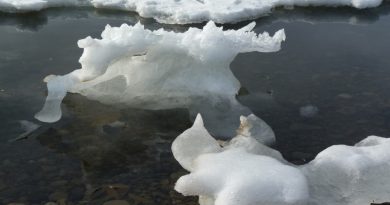For Alyeska dogs, avalanche rescue in Alaska is just a big game
 GIRDWOOD — For the dogs of Alyeska’s Patrol Avalanche Canine (PAC) program, the tough job of saving lives is “kind of a big game,” says Alyeska Resort ski patroller and dog handler Brian McGorry.
GIRDWOOD — For the dogs of Alyeska’s Patrol Avalanche Canine (PAC) program, the tough job of saving lives is “kind of a big game,” says Alyeska Resort ski patroller and dog handler Brian McGorry.
Not that they don’t take it seriously — the dogs train regularly to find and recover skiers and snowboarders buried by avalanches. They just don’t know how important their task is.
“Their entire existence is kind of a big game,” McGorry said. “The more fun you make the game, the better they do their job.”
This is apparent in the way the dogs attack that job. When it’s time to do a recovery, they bark excitedly, bounding up to snow caves where “subjects” — staged avalanche victims — are buried. They claw at the snow until they make a hole large enough for their small bodies to get through, then plunge into the den without a second thought.
The PAC program
The PAC program has been around since 2007, but its roots go back much further. The first Alyeska avalanche dog, Zooka — that’s short for Bazooka — is about 5-1/2 years old, says his handler, Mik Jedlicka. The program originally came into being thanks to help from Alaska Search and Rescue Dogs, which have been training canines for decades to assist in Alaska’s many search-and-rescue efforts, including avalanches. They were instrumental in helping train the Alyeska dogs, McGorry said, and remain an important part of the program.
The three PAC handlers and dogs — Jedlicka and Zooka, McGorry and his 4-year-old dog Fundy, and Tim Glassett and 2-1/2-year-old Yuki — also assist when needed on search and rescue operations outside of Alyeska, but they spend most of their days in the winter months at Alaska’s largest ski resort training and being on hand in case of an avalanche. Fortunately, Glassett said, they’ve never been called into action in the most urgent of ways — when a skier gets buried in an avalanche.
“The last couple of years, we’ve had some avalanches in the area, but nobody’s been buried in them,” Glassett said. “We’ve used them to clear areas, but they’ve never had to find a member of the public.”
But the dogs provide a valuable service, no matter how oblivious they are to the true nature of their job. And on Friday, the public can help support the program at a charity auction held at the Sitzmark Bar and Grill, located at the base of Alyeska. The auction helps fund the program, and additional training for the dogs and their handlers, which often takes them out of state. McGorry had just returned from a five-day training seminar near Salt Lake City with Wasatch Backcountry Rescue. They also hope to add another dog to the program in the near future, if they get enough funding and find the right handler.
All three dogs are male, and all three are Nova Scotia duck tolling retrievers, a specialized breed that is readily-trainable and relatively small — an important feature for a dog that spends much of its time hanging out on ski lifts. Though the tram at Alyeska is currently out of service after a New Year’s Eve accident, McGorry said the dogs prefer the open-air ski lifts over the often-crowded tram.
“Going up the lift is like a Sunday drive with the window down for them,” he said.
Multi-step training
The dogs are trained using a multi-step technique called the “Swiss Phase 4 Method” developed by the Swiss military and adopted by the Swiss Alpine Club. It entails varying degrees of separation from their handler and trainer during faux-rescues. The dogs are typically trained by placing a subject in a snow cave, blocking them in with new snow, then releasing the dog in an attempt to locate them. The dogs are then rewarded — Yuki goes for sausage treats, Fundy has a tug toy, and Zooka favors a sweater or jacket, typically made wool or polyester, which absorbs scent better, according to Jedlicka. Zooka tears pieces off while playing tug-of-war with Jedlicka after a successful recovery.
“Value Village loves us,” McGorry jokes.
The dogs are just one aspect of avalanche-rescue techniques. Other primary methods of recovery:
• Avalanche beacons worn by skiers and riders;
• Probes and shovels to delve into the snow, and
• The RECCO system, which features reflective tags built into ski gear.
But dogs are much more efficient than going into an area with just probes and shovels, hoping to find buried mountaineers. “The major thing with the dogs is that there are a lot of people around here who aren’t wearing a beacon,” Jedlicka said, “and a probe line can take hours and hours and hours.” Buried avalanche victims must be dug out quickly if they’re to survive, and once victims been buried an hour, the odds of survival are miniscule.
McGorry said that a team of probers could take about an hour to scout an acre’s worth of area, but the dogs can scout that same area in about 20 minutes. That’s precious time for a skier or snowboarder buried in one of the most-avalanche-prone regions in the U.S.
And if you’re unfortunate enough to be stuck in such a terrifying situation, what better rescue than a furry savior barging his way into a claustrophobic, suffocating cocoon of snow, looking to play?
The fourth-annual Alyeska ski patrol auction takes place at the Sitzmark Bar and Grill beginning at 8 p.m. on Friday, Jan. 25.
Contact Ben Anderson at ben(at)alaskadispatch.com
For more stories from Alaska Dispatch, click here



